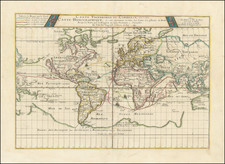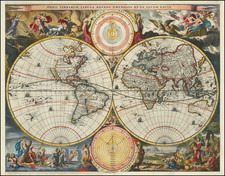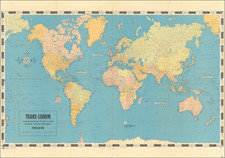Interesting Antarctic Details
This pair of very rare, large wall maps of the hemispheres was published in London circa 1864, under the direction of the Committee of General Literature & Education appointed by the Society for Promoting Christian Knowledge and of the National Society. These maps provide a rich, detailed representation of both hemispheres during a pivotal era of exploration and colonial expansion, with a noteworthy emphasis on the evolving understanding of the Antarctic region.
The mid-19th century was characterized by intensive global exploration and the expansion of European empires. Scientific, geographical, and anthropological knowledge was growing exponentially. These maps, with their detailed renderings of continents and countries, capture a world amid transformation.
Particularly notable is the maps’ depiction of the Antarctic, evidencing the discoveries made during the various expeditions of the early 19th century. Key features like Alexander I Land, discovered by Bellingshausen in 1820, and Graham Land, identified by Biscoe in 1832, are prominently marked. The maps also detail the discoveries of James Ross, who in February 1842 identified and named significant landmarks, including Mount Terror and Mount Erebus. The incorporation of these details exemplifies the blend of scientific inquiry and adventurous spirit that defined this period.
In the broader context, these maps stand as artifacts of an age where geographical knowledge was still being zealously sought. They embody the intersection of exploration, science, and the imperial aspirations of the powers of the era. The documents bear witness to the evolving understanding of a world where borders and territories were still the subjects of discovery and negotiation, offering insights into a pivotal period of global history and exploration.
Rarity
Very rare. OCLC records only the Easter Hemisphere, in one 1874 example, at Kyoto University.
The maps were likely published very sporadically into the 20th century under the aegis of Stanford.













![[Early Photographic Facsimile of the Rosselli-Sonetti Woodblock World Map] Figura & Scrittura in soma di tutti lo habitato](https://storage.googleapis.com/raremaps/img/small/66515.jpg)

![[ World on Mercator's Projection ] Mappe-Monde suivant la projection de Mercator -- 1832](https://storage.googleapis.com/raremaps/img/small/99031.jpg)
